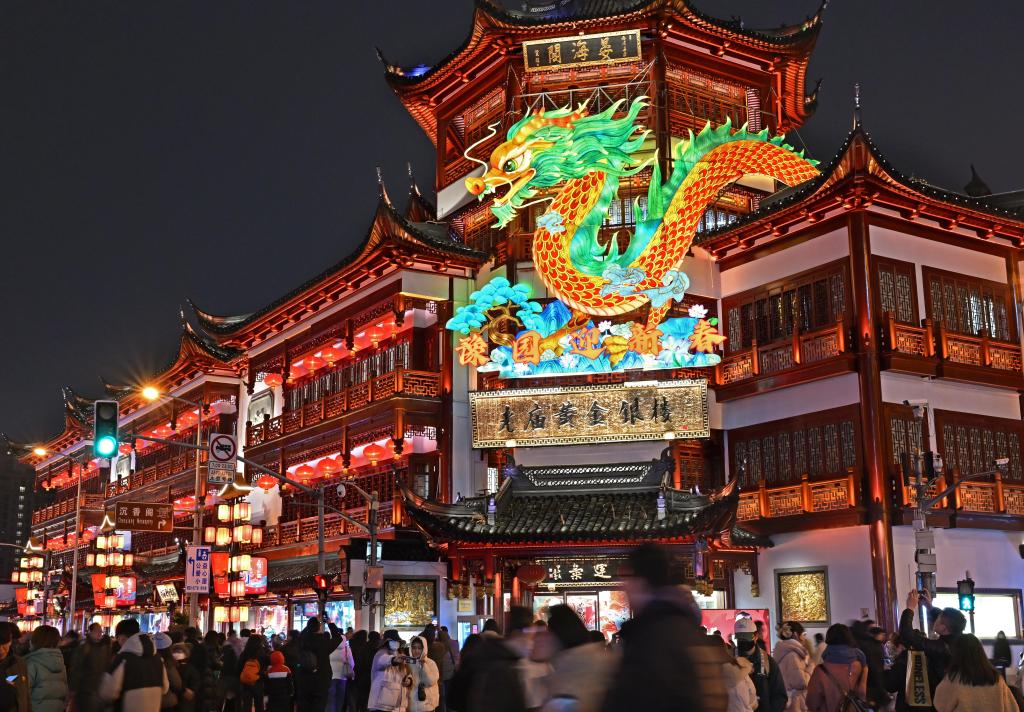Chinese New Year Travel Guide 🧧✈️: Embrace the festive spirit during the eight-day Spring Festival holiday in China! 🇨🇳
China’s enchanting tourist spots, featuring diverse ice-and-snow activities, tropical scenery, rich folk culture, and delectable delicacies, have become a magnet for foreigners. 🌏🏰
In mid-January, inbound travel orders surged more than 10 times year on year, marking a tourism boom during this significant holiday.
Attractions Worth Exploring:
- Harbin Ice-Snow World: Experience winter wonderland in the “ice city” with captivating Year of the Dragon scenes, ice biking, snowmobiling, and a thrilling Ferris wheel ride.
- Changbai Mountain Ski Resorts: Skiing enthusiasts can enjoy top-notch resorts and the scenic Tianchi crater lake in Jilin Province, just a train ride away from Harbin.
- Sanya’s Tropical Paradise: Head to the coastal city of Sanya in Hainan for sunbathing, underwater adventures, and vibrant Spring Festival events.
- Kunming’s Spring City Charms: Explore Yunnan’s capital with its balmy weather, black-headed gulls, stone forests, and karst landforms.
- Pingyao’s Ancient Heritage: Dive into history in Shanxi Province’s Pingyao, where ancient architecture and traditional festivities await.

Unique Customs and Festivities:
- Temple Fairs in Beijing: Immerse yourself in traditional lantern shows, local cuisine, and Chinese crafts at Ditan Park and Longtan Park.
- Guangzhou’s Dragon and Lion Dances: Join the lively celebrations in Guangdong with vibrant parades and a spectacular fireworks display.
- Shanghai’s Yuyuan Garden Lantern Show: Witness enchanting scenes, including the zodiac dragon lantern, for a splendid traditional Chinese atmosphere.

Delectable Cuisine:
- Beijing Roast Duck: Indulge in the iconic Peking Duck at Quanjude in Qianmen, complemented by the festive atmosphere of the area.
- Sichuan and Chongqing Spicy Hot Pot: For spice lovers, explore authentic “mala” cuisine in these regions for a fiery culinary adventure.
- Cantonese Delights in Greater Bay Area: Enjoy the freshness of Cantonese cuisine, including dim sum, boiled shrimp, and steamed spareribs, in the Guangdong-Hong Kong-Macao Greater Bay Area.

Travel Tips for Convenience:
- Use Travel Apps: Opt for Trip.com or Qunar.com for easy bookings and contact their helpline for assistance.
- Dining Exploration: Discover a variety of dining options using Meituan and Dianping apps, offering reviews from upscale restaurants to hidden gems.
- Navigation with Baidu Map: Confidently navigate China using Baidu Map for directions and even hailing cabs, similar to Didi.
- Digital Payments: Make hassle-free payments through Alipay and WeChat Pay, accepting international bank cards.
- Plan Smart: Avoid peak travel times, plan for the middle of the holiday, and check the opening hours of scenic spots and restaurants to ensure a smooth trip. 🗺️🧳 #SpringFestival #TravelChina

In China, the Chinese New Year, also known as the Spring Festival, is a significant public holiday, and it marks the beginning of the traditional lunar new year. During this period, there is an extended holiday known as the Spring Festival Golden Week. Apart from the Chinese New Year, there are other public holidays that may be associated with the festival season. Here is a list of public holidays in China during the Chinese New Year:
- Chinese New Year (Spring Festival): The main holiday, celebrated on the first day of the Chinese lunar calendar. The date varies each year but usually falls between January 21 and February 20.
- New Year’s Eve: The evening before Chinese New Year is also a time for family reunions and celebrations.
- Spring Festival Golden Week: This is an extended holiday period, typically lasting for about seven days, starting from Chinese New Year’s Eve. The exact dates may vary.
- Lantern Festival: The 15th day of the first lunar month marks the end of the Chinese New Year celebrations with lantern displays and various activities.
- Qingming Festival (Tomb-Sweeping Day): Not directly related to the Chinese New Year, Qingming Festival usually occurs in early April. It’s a time for families to honor ancestors by visiting their graves.
- May Day (Labor Day): Celebrated on May 1st, this holiday is part of the Golden Week, allowing for an extended break.
- Dragon Boat Festival: Falling on the 5th day of the 5th lunar month, which is usually in June, this festival involves dragon boat races and the consumption of traditional rice dumplings.
- Mid-Autumn Festival: Celebrated on the 15th day of the 8th lunar month, usually in September, this festival is known for mooncakes and family reunions.
- National Day Golden Week: Celebrated around October 1st, National Day marks the founding of the People’s Republic of China. The Golden Week includes several days off for celebrations.
Chinese New Year, also known as the Spring Festival, holds immense cultural, social, and familial significance for the Chinese people. It is the most important traditional festival in Chinese culture and is celebrated not only in Mainland China but also by Chinese communities around the world. The festival is deeply rooted in ancient customs, folklore, and spiritual beliefs, and its significance can be understood through various aspects:
- Family Reunion: Chinese New Year is synonymous with family reunions. It is a time when family members make a special effort to come together, regardless of where they are, to celebrate the festival. The reunion dinner on Chinese New Year’s Eve is one of the most important meals of the year, emphasizing the importance of family bonds.
- Symbol of Renewal and Fresh Beginnings: The festival marks the beginning of the lunar new year and is associated with the concept of renewal and fresh starts. It is a time to bid farewell to the old year and welcome the new with optimism and hope.
- Traditional Customs and Rituals: Chinese New Year is rich in customs and rituals that are believed to bring good luck, prosperity, and happiness. Activities such as cleaning and decorating homes, offering sacrifices to ancestors, lighting firecrackers, and displaying auspicious symbols play a significant role in the festivities.
- Lunar New Year Zodiac: Each year in the Chinese zodiac is associated with one of the twelve animals. The festival marks the transition to a new zodiac sign, and people believe that the characteristics of the animal of the year influence the personalities of those born in that year.
- Warding off Evil Spirits: Traditionally, the loud noise of firecrackers and the use of red decorations are believed to scare away evil spirits and bring good fortune. Red is considered a lucky color in Chinese culture.
- Giving and Receiving Red Packets (Hongbao): Red packets, or “hongbao,” are monetary gifts placed in red envelopes given to children, unmarried adults, and sometimes elderly relatives. The red color symbolizes good luck and is believed to ward off evil spirits.
- Community Celebrations: Beyond family gatherings, Chinese New Year is also a time for community celebrations. Public events, parades, dragon and lion dances, and various cultural performances take place, fostering a sense of community and shared cultural identity.
- Culinary Traditions: Special foods are prepared during the festival, each with its own symbolic meaning. For example, fish symbolizes surplus and wealth, while dumplings are associated with wealth and good fortune.
- Travel Tradition: Many people in China travel back to their hometowns to be with their families during the festival. This massive movement of people, known as the Spring Festival travel rush or Chunyun, is one of the world’s largest human migrations.
In essence, Chinese New Year is a time for reflection, gratitude, and the strengthening of bonds within the family and community. It is a celebration deeply ingrained in Chinese cultural heritage, carrying forward traditions that have been passed down through generations.
Chinese New Year, also known as the Spring Festival, is primarily a Chinese cultural celebration, but its influence extends far beyond China’s borders. While the most elaborate and traditional celebrations occur in regions with significant Chinese communities, many people around the world, irrespective of their cultural backgrounds, join in the festivities to welcome the Chinese lunar New Year. Here’s how the entire world celebrates Chinese New Year:
- Chinese Diaspora Celebrations:
- Chinatowns and Chinese Communities: Cities with prominent Chinese communities, such as San Francisco, New York, London, Sydney, and many others, host elaborate celebrations in their Chinatown districts. These celebrations often include traditional performances, dragon and lion dances, parades, and vibrant decorations.
- Public Events and Festivals:
- Public Celebrations: Beyond Chinese-majority regions, many cities across the globe organize public events and festivals to celebrate Chinese New Year. These events often feature cultural performances, martial arts demonstrations, and exhibitions of traditional Chinese art and crafts.
- Cultural Institutions and Museums:
- Exhibitions and Workshops: Museums and cultural institutions around the world curate exhibitions and workshops centered around Chinese art, history, and traditions during the Lunar New Year. This provides people from diverse backgrounds with an opportunity to learn about and engage with Chinese culture.
- Educational Institutions:
- School Celebrations: Schools and universities in various countries incorporate Chinese New Year celebrations into their curriculum. Students may participate in activities like making traditional crafts, learning about Chinese customs, and enjoying festive meals.
- Corporate Celebrations:
- Workplace Celebrations: Some multinational corporations, especially those with a presence in China or strong ties to Chinese markets, embrace the festive spirit. Companies may organize internal celebrations, decorate offices, and even give employees time off to celebrate with their families.
- Retail and Commercial Participation:
- Festive Merchandising: Retailers around the world often tap into the festive mood by offering Chinese New Year-themed products and decorations. The iconic red and gold colors associated with good luck and prosperity are prevalent in these merchandise displays.
- Culinary Experiences:
- Special Menus: Restaurants and eateries in diverse locations introduce special Chinese New Year menus, featuring traditional dishes. This provides an opportunity for people to experience and savor Chinese culinary traditions.
- Social Media and Online Celebrations:
- Virtual Celebrations: In the digital age, people worldwide join the celebration virtually. Social media platforms showcase Chinese New Year festivities, and people share their experiences, greetings, and well-wishes across the globe.
- Educational and Cultural Exchange Programs:
- Cultural Exchange: Educational and cultural exchange programs often incorporate Chinese New Year celebrations. Students from China or those studying Chinese language and culture may share their traditions with their international peers.
- Tourist Attractions:
- Global Landmarks: Some global landmarks and tourist attractions illuminate with red and gold lights in honor of Chinese New Year. This symbolic gesture extends warm wishes to the global Chinese community.
While the scale and nature of celebrations vary, the global observance of Chinese New Year reflects a shared appreciation for cultural diversity and the joyous spirit of welcoming a new beginning. It highlights the interconnectedness of the world and the ability of cultural celebrations to transcend borders and foster unity.
Chinese New Year, also known as the Spring Festival, is a time of joy, family gatherings, and delicious feasts. Traditional Chinese New Year foods hold symbolic meanings associated with luck, prosperity, and good fortune. Here are some customary dishes enjoyed during this festive season:
- Dumplings (Jiaozi):
- Symbolism: Dumplings are shaped like ancient Chinese gold or silver ingots, representing wealth and prosperity.
- Preparation: Families often gather to make dumplings together, filling them with a mixture of minced meat, vegetables, and seasonings.
- Spring Rolls (Chun Juan):
- Symbolism: Their cylindrical shape resembles gold bars, symbolizing wealth and prosperity.
- Preparation: Spring rolls are filled with vegetables, meat, or a combination of both and are usually deep-fried until crispy.
- Nian Gao (Sticky Rice Cake):
- Symbolism: “Nian” means year, and “gao” sounds like “tall” or “high,” symbolizing growth, progress, and the promise of a better year.
- Preparation: This sticky rice cake can be steamed or pan-fried and is often enjoyed sweet or savory.
- Fish (Yu):
- Symbolism: The Chinese word for fish, “yu,” sounds like the word for surplus or abundance, representing prosperity and wealth.
- Preparation: Whole fish is commonly served, symbolizing a good start and finish to the year.
- Tangyuan (Sweet Rice Balls):
- Symbolism: Tangyuan represents family unity and harmony.
- Preparation: These glutinous rice balls are usually filled with sweet fillings like sesame paste, red bean paste, or peanuts and served in a sweet soup.
- Jiuniang (Sweet Rice Wine):
- Symbolism: Jiuniang is associated with the wish for a sweet and harmonious life.
- Preparation: This fermented sweet rice wine is consumed during the festival, especially in northern China.
- Longevity Noodles (Changshou Mian):
- Symbolism: The long noodles are associated with a long and healthy life.
- Preparation: Noodles are served uncut, symbolizing longevity. They can be stir-fried, boiled, or served in soup.
- Pomelos (Youzi):
- Symbolism: The round shape and golden color symbolize abundance and prosperity.
- Preparation: Pomelos are often gifted and consumed as a symbol of good luck and blessings for the coming year.
- Fruits:
- Symbolism: Different fruits carry various meanings; for example, tangerines and oranges symbolize luck and wealth.
- Preparation: A fruit tray with a variety of fruits is a common sight during Chinese New Year celebrations.
- Eight Treasure Rice (Babao Fan):
- Symbolism: This dish symbolizes wealth and abundance with its mixture of eight different ingredients.
- Preparation: Glutinous rice is combined with various dried fruits, nuts, and seeds to create a rich and flavorful dessert.
These traditional Chinese New Year foods not only delight the taste buds but also carry deep cultural significance, creating a meaningful connection between generations and reinforcing the spirit of the festival.
Shayne Heffernan









